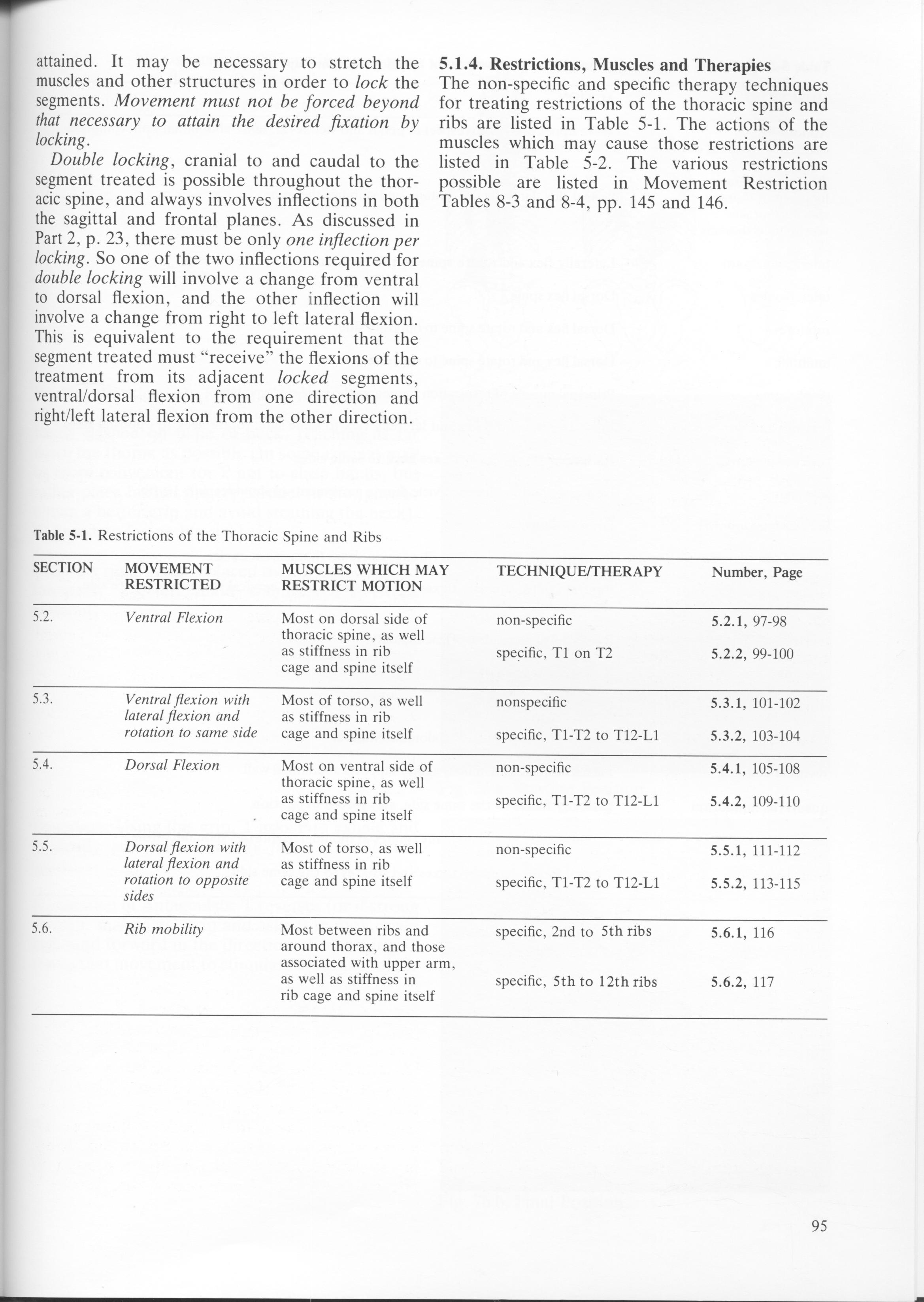95 (145)

attained. It may be necessary to stretch the muscles and other structures in order to lock the segments. Movement must not be forced beyond that necessary to attain the desired fixation by locking.
Double locking, cranial to and caudal to the segment treated is possible throughout the thor-acic spine, and always involves inflections in both the sagittal and frontal planes. As discussed in Part 2, p. 23, there must be only one inflection per locking. So one of the two inflections required for double locking will involve a change from ventral to dorsal flexion, and the other inflection will involve a change from right to left lateral flexion. This is equivalent to the requirement that the segment treated must “receive” the flexions of the treatment from its adjacent locked segments, ventral/dorsal flexion from one direction and right/left lateral flexion from the other direction.
5.1.4. Restrictions, Muscles and Therapies
The non-specific and specific therapy techniques for treating restrictions of the thoracic spine and ribs are listed in Table 5-1. The actions of the muscles which may cause those restrictions are listed in Table 5-2. The various restrictions possible are listed in Movement Restriction Tables 8-3 and 8-4, pp. 145 and 146.
Table 5-1. Restrictions of the Thoracic Spine and Ribs
|
SECTION |
MOVEMENT RESTRICTED |
MUSCLES WHICH MAY RESTRICT MOTION |
TECHNIQUE/THERAPY |
Number, Page |
|
5.2. |
Ventral Flexion |
Most on dorsal side of thoracic spine, as well as stiffness in rib cage and spine itself |
non-specific specific, Tl on T2 |
5.2.1, 97-98 5.2.2, 99-100 |
|
5.3. |
Ventral flexion with lateral flexion and |
Most of torso, as well as stiffness in rib |
nonspecific |
5.3.1, 101-102 |
|
rotation to same side |
cage and spine itself |
specific, T1-T2 to T12-L1 |
5.3.2, 103-104 | |
|
5.4. |
Dorsal Flexion |
Most on ventral side of thoracic spine, as well as stiffness in rib cage and spine itself |
non-specific specific, T1-T2 to T12-L1 |
5.4.1, 105-108 5.4.2, 109-110 |
|
5.5. |
Dorsal flexion with lateral flexion and |
Most of torso, as well as stiffness in rib |
non-specific |
5.5.1, 111-112 |
|
rotation to opposite sides |
cage and spine itself |
specific, T1-T2 to T12-L1 |
5.5.2, 113-115 | |
|
5.6. |
Rib mobility |
Most between ribs and around thorax, and those associated with upper arm, as well as stiffness in rib cage and spine itself |
specific, 2nd to 5th ribs specific, 5th to 12thribs |
5.6.1, 116 5.6.2, 117 |
95
Wyszukiwarka
Podobne podstrony:
26776 skanuj0084 (20) 87 DYLEMATY WIEJSKIEJ TURYSTYKI KULTUROWEJ authońs opinion it may be assumed t
DSCF9385 WOtn* 269*2 P used, it may be hoflow, provlded thot the diameter of tbe hole doaa not excee
mbs 006 THE AUTHOR’S PREFACE TO THE FIRST EDITION It may be a inatter of surprise to sonie that I sl
16ccw02 xj Security Information You are about to send several lines of text over the Internet. It ma
15 UN DEBAT : LES MENTALTTES COLLECTIVES 605 the Governor of the Town to enąuire whether it wil
Scannen0027 20 A ASBi" Six Men A-Sitting X ■}*■&* LTT$v*0 It may be Guiness business to fi
do not receive any attention bccause time is reduced to three minutes — and it may be even further r
109 Spain This point is drivcn by a 32 mm rod to which it may be fixed or simply supported, in which
system 09 9INTRODUCTION It may be of interest to English readers to know a little morę than he himse
Panda It may be extremely rare for a panda family in a zoo to produce a cub, but it s not a pro
więcej podobnych podstron